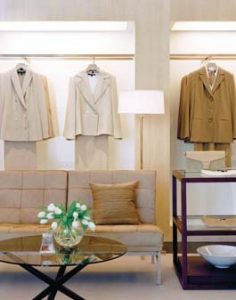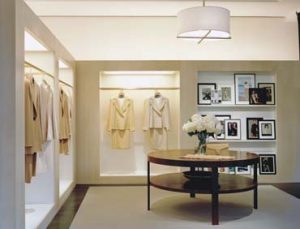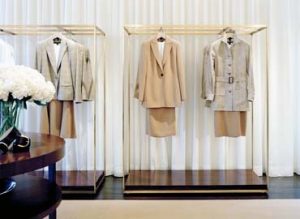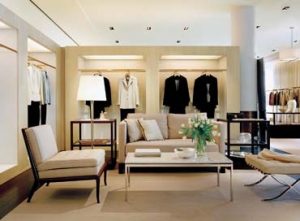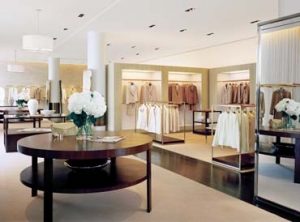There's a backstory to the first free-standing Ellen Tracy store, in Manhasset's Americana Mall on New York's Long Island. It's Ellen Tracy living the American dream, which encourages the ambitious to make a success and build their family a dream house.
There's the dream. There's the success. There's the house. But there's no Ellen Tracy.
Herbert Gallen invented the name for his new blouse company in 1949. It was already doing well when he hired Linda Allard as a design assistant in 1962, a fresh college graduate with only $200 in her pocket, “riding a lot of elevators” looking for a job.
Two years later, Allard became design director and the company expanded along with the role of women in the corporate world. (Much later, in 2000, she also became Mrs. Gallen, known as a generous philanthropist, serious gardener and the author/ illustrator of her own published cookbook.)
Fast-forward to today. The Ellen Tracy label appears in many other categories besides business suits, including shoes, outerwear, hosiery, belts, scarves, jewelry, handbags and fragrances. In addition to the Ellen Tracy collection, there is also the petites line, a plus-size division and Company Ellen Tracy, a weekend and casual work line. All have been sold exclusively at department stores like Saks Fifth Avenue, Neiman Marcus and Macy's.
In 2002, Liz Claiborne bought the company, and the next year Allard retired, but not before imprinting her aesthetic and attitude on this Manhasset store, intended as the prototype for a national roll-out.
Advertisement
Appropriately, Ellen Tracy tapped S. Russell Groves to build this first store. Celebrated for his sophisticated-yet-simple approach to high-end residential and retail projects, Groves' signature spaces exude classic appeal with a contemporary edge: Takashimaya's Tea Box restaurant in New York, Giorgio Armani in Bal Harbour, Fla., and Coach flagships in New York, Boston and San Francisco.
“Allard's first words to me were, 'modern, residential and luxurious,'” Groves recalls. “Those words can mean a million things, but they were the recipe, so we had to make sure that they worked together. Modern can sometimes be cold and sterile, and that's not what we were after.”
For that not-cold-or-sterile interior sensibility, Groves turned to American mid-century modernists like Charles and Ray Eames and Florence and Hans Knoll (like Allard and Gallen, partners in love and business). There is an original Florence Knoll metal sofa upholstered in beige cowhide, as well as period pieces by Paul McCobb and T.H. Robsjohn-Gibbings.
“We wanted to keep the space open and as light as possible,” says Groves. “There are beautiful windows on two sides and we didn't close them off for display, we let them be part of the store.”
The space is subdivided into three areas. Casual to eveningwear is all in one location, but arranged as if in different rooms of a house, such as a living room or a grand hall. There is also a picture gallery of old ad campaigns framed as if family portraits, enhancing the impression that shoppers are entering Ellen Tracy's home.
“As we became more immersed in the Ellen Tracy persona,” Groves explains, “we kept gravitating to what does it mean to be American? In their ads, they had included a woman carrying a baby or a briefcase, communicating that the Ellen Tracy woman had a life. She was a woman who was interested in fashion but not dominated by it.”
Advertisement
Textured natural materials are used throughout the store: a focal wall of travertine, bleached rift oak framing the clothing racks, ebony and mahogany fixtures. Burnished bronze and a mixture of shiny and matte surfaces lend a subtle richness to the cream-champagne beige-rich brown palette.
By referencing the early decades of the brand's launch in the store's aesthetics, Ellen Tracy succeeds in turning 56 into her dream-fulfillment year– looking her best in the comfort of her own home.
Client: Liz Claiborne Inc., New York
Design: S. Russell Groves, New York
S. Russell Groves, founder
General Contractor: Nelson Construction, Paramus, N.J.
Lighting Consultant: Cooley Monato Studio, New York
MEP Consultant: G.C. Eng, New York
Advertisement
Structural Engineer: Murray Engineering PC, New York
Bath Vanity: Boffi, Milan, Italy
Carpet: Patterson Flynn Martin, New York
Cocktail Tables: DW Woods, Brooklyn, N.Y.
Knoll, New York
Desks and Desk Chairs: Pucci Intl., New York
Drapery: Carnegie, Rockville Centre, N.Y.
Fitting Room Benches: Design Within Reach, San Francisco
Floor Lamps: Nessen, Mamaroneck, N.Y.
Hinson, Long Island City, N.Y.
Flooring: Azrock by Tarkett, Houston
Syracuse Commercial Floors, East Syracuse, N.Y.
Lounge Chairs: Dennis Miller, New York
Metalwork: J.R. Wire, Winnepeg, Man.
Millwork: Builders Furniture, Winnepeg, Man.
Paint: Benjamin Moore, Montvale, N.J.
Pendant Lamps: SRG, New York
Plumbing Fixtures: Dornbacht, Duluth, Ga.
Sofas: Knoll, New York
Holly Hunt, New York
Tile: American Olean, Dallas
Photography: Michael Moran, New York
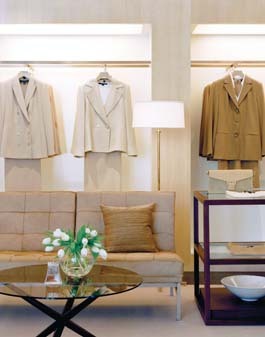

 Headlines2 weeks ago
Headlines2 weeks ago
 Headlines2 weeks ago
Headlines2 weeks ago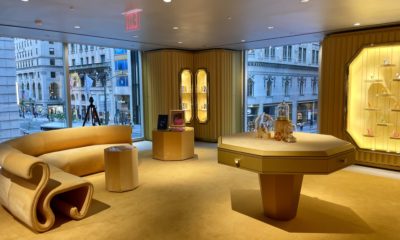
 Eric Feigenbaum6 days ago
Eric Feigenbaum6 days ago
 Headlines1 week ago
Headlines1 week ago
 Headlines1 week ago
Headlines1 week ago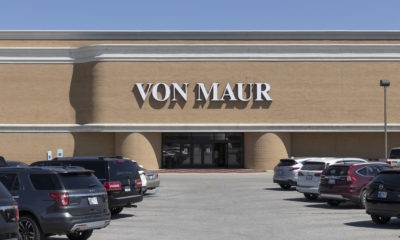
 Headlines4 days ago
Headlines4 days ago
 Headlines6 days ago
Headlines6 days ago
